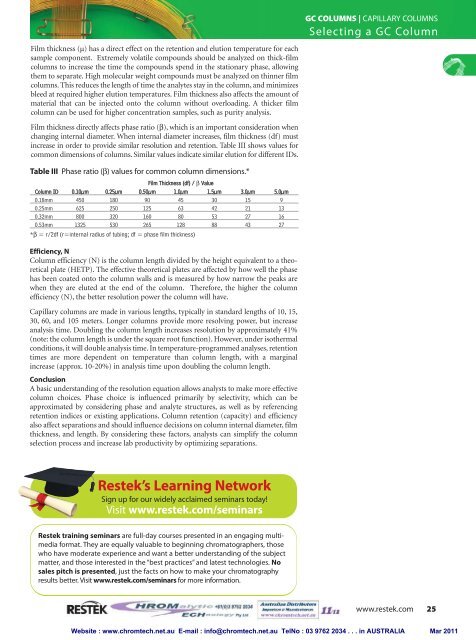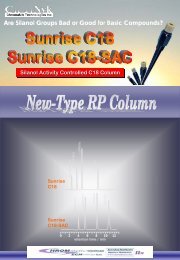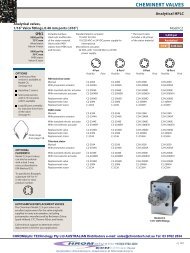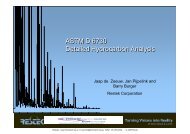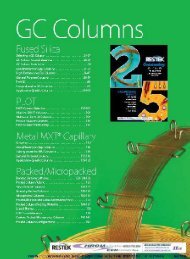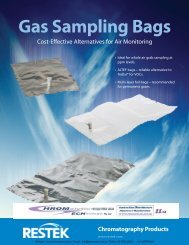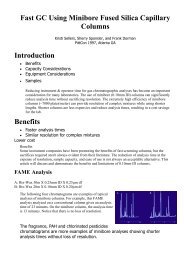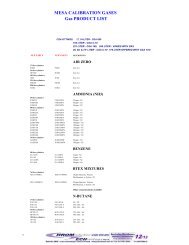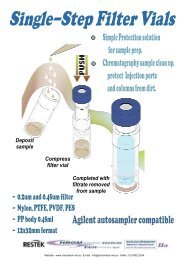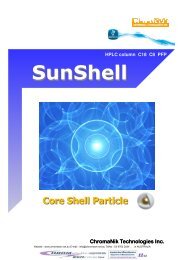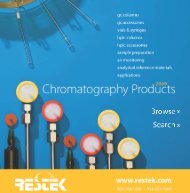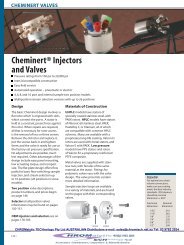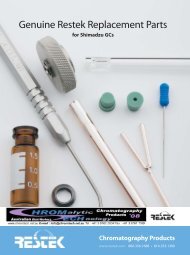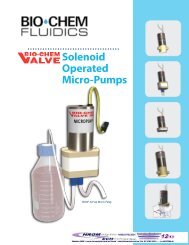Create successful ePaper yourself
Turn your PDF publications into a flip-book with our unique Google optimized e-Paper software.
GC COLUMNS | CAPILLARY COLUMNS<br />
Selecting a GC Column<br />
Film thickness (µ) has a direct effect on the retention and elution temperature for each<br />
sample component. Extremely volatile compounds should be analyzed on thick-film<br />
<strong>columns</strong> to increase the time the compounds spend in the stationary phase, allowing<br />
them to separate. High molecular weight compounds must be analyzed on thinner film<br />
<strong>columns</strong>. This reduces the length of time the analytes stay in the column, and minimizes<br />
bleed at required higher elution temperatures. Film thickness also affects the amount of<br />
material that can be injected onto the column without overloading. A thicker film<br />
column can be used for higher concentration samples, such as purity analysis.<br />
Film thickness directly affects phase ratio (β), which is an important consideration when<br />
changing internal diameter. When internal diameter increases, film thickness (df) must<br />
increase in order to provide similar resolution and retention. Table III shows values for<br />
common dimensions of <strong>columns</strong>. Similar values indicate similar elution for different IDs.<br />
Table III Phase ratio (β) values for common column dimensions.*<br />
Film Thickness (df) / β Value<br />
Column ID 0.10µm 0.25µm 0.50µm 1.0µm 1.5µm 3.0µm 5.0µm<br />
0.18mm 450 180 90 45 30 15 9<br />
0.25mm 625 250 125 63 42 21 13<br />
0.32mm 800 320 160 80 53 27 16<br />
0.53mm 1325 530 265 128 88 43 27<br />
*β = r/2df (r=internal radius of tubing; df = phase film thickness)<br />
Efficiency, N<br />
Column efficiency (N) is the column length divided by the height equivalent to a theoretical<br />
plate (HETP). The effective theoretical plates are affected by how well the phase<br />
has been coated onto the column walls and is measured by how narrow the peaks are<br />
when they are eluted at the end of the column. Therefore, the higher the column<br />
efficiency (N), the better resolution power the column will have.<br />
Capillary <strong>columns</strong> are made in various lengths, typically in standard lengths of 10, 15,<br />
30, 60, and 105 meters. Longer <strong>columns</strong> provide more resolving power, but increase<br />
analysis time. Doubling the column length increases resolution by approximately 41%<br />
(note: the column length is under the square root function). However, under isothermal<br />
conditions, it will double analysis time. In temperature-programmed analyses, retention<br />
times are more dependent on temperature than column length, with a marginal<br />
increase (approx. 10-20%) in analysis time upon doubling the column length.<br />
Conclusion<br />
A basic understanding of the resolution equation allows analysts to make more effective<br />
column choices. Phase choice is influenced primarily by selectivity, which can be<br />
approximated by considering phase and analyte structures, as well as by referencing<br />
retention indices or existing applications. Column retention (capacity) and efficiency<br />
also affect separations and should influence decisions on column internal diameter, film<br />
thickness, and length. By considering these factors, analysts can simplify the column<br />
selection process and increase lab productivity by optimizing separations.<br />
Restek’s Learning Network<br />
Sign up for our widely acclaimed seminars today!<br />
Visit www.restek.com/seminars<br />
Restek training seminars are full-day courses presented in an engaging multimedia<br />
format. They are equally valuable to beginning chromatographers, those<br />
who have moderate experience and want a better understanding of the subject<br />
matter, and those interested in the “best practices” and latest technologies. No<br />
sales pitch is presented, just the facts on how to make your chromatography<br />
results better. Visit www.restek.com/seminars for more information.<br />
www.restek.com 25<br />
Website : www.chromtech.net.au E-mail : info@chromtech.net.au TelNo : 03 9762 2034 . . . in AUSTRALIA Mar 2011


